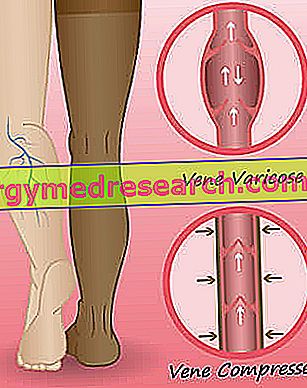Generality
Graduated compression stockings represent one of the most widely used remedies in all those cases in which the return of venous blood to the heart is reduced (venous insufficiency); this is the case, for example, of varicose veins.
In other circumstances, elastic stockings can be used for preventive purposes, as in the case in which we want to prevent the formation of thrombus, for example, in patients bedridden after surgery.

For elastic stockings to perform their therapeutic action best, it is good to wear them in the morning before getting out of bed and before the legs start to swell.
Types and modes of action
Graduated compression stockings act by exerting a graduated compression, which is maximum at the ankle level and then gradually decreases to the knee or thigh (depending on the type of sock used: knee-high, hold-up, pantyhose or single-legged) .

Preventive and Therapeutic Elastic Stockings
There are two different types of elastic stockings: preventive elastic stockings and therapeutic stockings.
What differentiates these two types of elastic stockings is basically the pressure they exert on the legs. More specifically, the pressure exerted at the ankle level, which is measured in millimeters of mercury (mmHg).
Preventive elastic stockings, in fact, must exert an ankle pressure of at least 6 mmHg, up to a maximum of about 15-20 mmHg.
The therapeutic elastic stockings, on the other hand, exert an ankle compression that goes, approximately, from about 20 mmHg up to over 40 mmHg.
Depending on the degree of pressure applied to the ankle, therapeutic elastic stockings can be divided as follows:
- Compression class I (ankle compression of 18-20 mmHg );
- Compression class II (ankle compression of 21-32 mmHg );
- Compression class III (ankle compression of 33-46 mmHg );
- Compression class IV (ankle compression greater than 49 mmHg ).
Finally, it should be remembered that the use of therapeutic elastic stockings should only be prescribed by specialists, following accurate medical examinations and only after excluding the possible presence of concomitant arterial diseases or diabetes. In fact, if the patient is also affected by any of these disorders, the use of elastic stockings could even be harmful.
How to wear elastic stockings
Since these are stockings that can exert high pressure on the leg, patients often have many difficulties in wearing this particular type of medical device.
To overcome this inconvenience, different types of stock- locks are available on the market, devised precisely to facilitate this task.
Another trick that can be adopted consists in wearing a pair of gloves, in order to improve the grip of the hands on the stockings. Furthermore, with the use of gloves, there is no risk of damaging the sock with nails during the insertion process.
Once worn, it is essential that the stockings do not make folds, so as to avoid excessive compression in certain areas, as it is essential not to stretch them too much, thus affecting the degree of compression exercised by them.
Of course - in addition to choosing the right degree of compression needed to prevent or treat the disease afflicting each patient - elastic stockings must be of the right size. The choice of the correct size will depend on the height and weight of each individual, as well as the size of the circumferences of the ankle, calf and thigh.
Useful tips
To prolong the efficiency of elastic stockings
Being medical devices that must be used daily, elastic stockings tend to deteriorate and lose their efficiency rather quickly.
Below are some simple tips that - if followed correctly - can prolong their efficiency:
- Wash the elastic stockings by hand, at a low temperature (below 40 ° C) and with neutral and non-aggressive detergents;
- During washing, avoid squeezing the elastic stockings so as not to damage the fibers;
- After washing, thoroughly rinse the socks using plenty of warm water;
- Allow the socks to dry in a horizontal position (possibly on a flat surface), never tensioned or hung up, and away from heat sources of any kind;
- Use gloves to wear elastic stockings, so as to avoid damaging the fibers which can occur, for example, following contact of the device with rings or nails.



